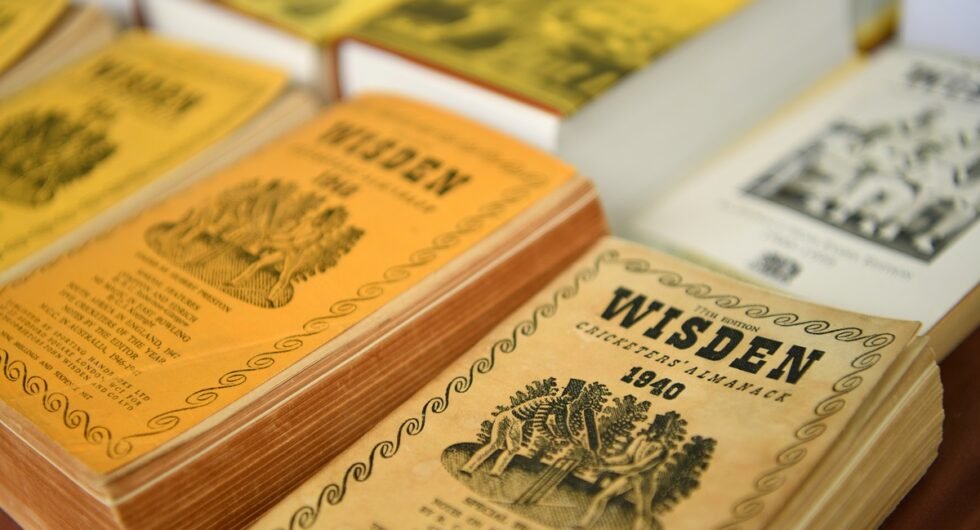Collecting Wisden: The thrill of the chase – Almanack

@theoldbatsman 15 minute read
Jon Hotten’s piece on collecting Wisden Almanacks originally appeared in the 2023 edition of Wisden Cricketer’s Almanack.
In May 2022, Chris Ridler got in his car, a gold BMW with the licence plate WI5DEN, and “www.wisdenauction.com – start your collection today” emblazoned across the bonnet, and drove from his home near Huddersfield to Tennants auction house in Leyburn, North Yorkshire. He still couldn’t believe what he had seen, but was hoping he was the only one who had. It was a lot in the Books, Maps and Manuscripts sale, described as “a complete run” of Wisden Cricketers’ Almanack from 1864 to 2018, including 17 facsimiles. What caught his eye was an estimated price of £2,000–3,000, extremely low – even with the facsimiles, inevitably the earliest editions, plus 1916, which includes the obituaries of WG Grace and Victor Trumper.
“There was one photograph in the online catalogue and, when I zoomed in, it looked like there were some original hardbacks,” said Ridler. “They’re the ones you really want, the early hardbacks, which didn’t start until 1896. There’s some proper money in those. There were also three volumes – 1890, ’91, ’92 – that had been rebound, which made me wonder whether the hardbacks from later in the decade might also have been rebound. I couldn’t tell from the photo, so I had to go and have a look. I was amazed to discover there were some original hardbacks, and two from the later 1890s were worth about £7,000 each. And the three from 1917 to 1919 might together go for £9,000-plus.”
He looked around, anxious to see if he recognised another dealer. To his astonishment and delight, there was just one other bidder, via telephone. “I ended up paying about £13,000. I would have gone to high twenties. Some guy at the back said: ‘I think you’ve done rather well there…’”
In the internet age, coups are rare in antiquarian books: charity shops employ their own consultants, and the market price of almost any title ever published is only a click away. In the small and cloistered world of Wisden, where men – and it is almost always men – spend half a lifetime in search of a full set, assisted by the most knowledgeable of dealers and fellow enthusiasts, it simply does not happen.
The Almanack was first published in 1864, limp-bound with paper covers, and cost a shilling. It stayed that way – the covers varying between salmon pink, yellow and buff – until 1896, when a cloth-bound hardback edition emerged too, priced at two shillings. The soft cover changed to a yellow linen in 1938, when the Eric Ravilious wood engraving first appeared; in 1965, a dust jacket was added to the hardcover. A company called Willows produced a series of facsimiles, and a brief survey of the market will find rebound editions, and books with new spines or replacement pages. Since 1995, Wisden have produced a leather-bound edition, limited to 150 copies. And that, to all intents and purposes, is what there is to collect. No one can be sure how many early editions remain, how many complete sets lie in libraries or private hands, or what really constitutes a true full set. Do facsimiles count? And what about second editions? Or paperbacks rebound as hardbacks?
Bill Furmedge began his quest in a Liverpool library, where he saw his first copy of Wisden and, despite knowing nothing about cricket, became gripped by the names and numbers. His friend was tempted to steal it on his behalf by hiding it under the hood of his parka, but Bill knew that would be wrong, especially for this book.
“The first one I bought was the 1979, and I completed my set in 2006 – through being a student, getting a job, having a family. The last one I needed was an 1869 paperback and, when I got it, I felt…” He hesitates, looking for the right word: “… disappointed.” He laughs, but he has summed up the nature of collecting. The thrill is in the chase.
Like Ridler, who began his collection while working as a management consultant, Furmedge gave up a career (in publishing) to deal exclusively in the Almanack, which he does through his website, wisdenworld.com. Neither earns the money they once did: Ridler estimates he could make a month’s worth of Wisden profits in two days’ management consultancy. But other rewards come from their immersion in this arcane environment.
If, like the composer Tim Rice, you had bought a full set in 1972 for £750, your investment would have paid off at a much better rate than if you’d bought the average UK house, for just over £6,000. Today, that house would be worth perhaps £286,000, the Wisdens around £100,000. “Even taking into account some years of manic inflation since the purchase,” writes Sir Tim in his foreword to The Wisden Collector’s Guide, “I suspect the most voracious hedge-fund manager would be quite relaxed about my investment.”
As with the housing ladder, though, later entry is not without risk. Christopher Saunders began selling cricket books from a shop in Wells, Somerset, in 1978, and went on to become – with John McKenzie of Epsom – one of the country’s greatest specialists in the market. He recognises Wisden’s boom years are gone, at least for now: “I bought sets that people had bought in the 1960s for £250. They’ve obviously gone up. They went up hugely in the ’80s and ’90s, and continued rising until the financial crash of 2008. After that, for some reason confidence went, and the internet rose, and people could see that most Wisdens weren’t as scarce as they thought they were, so prices came down.
“So 1864, at the top of the market in 2008, with wrappers, covers, was 25 grand; without, probably 15. Now it’s more like 15 to 20 with the covers; without, you’re lucky to get seven. And as the generation that bought their sets in the ’60s die off, more [books] come to the market. There are more sellers.”
The number of sets is limited, of course, by the number of copies of the rarest year. For reasons no one quite knows, this is 1875. “In original covers, it is very rare,” says Saunders. “I bought one at Christie’s for a customer about two years ago, and paid almost £40,000. Without covers, it might be half as much.” Furmedge went nearly three years without seeing a single copy. Find an 1875 and you must still track down an 1869, the next hardest. Of the early hardbacks, 1896 is also difficult, according to Saunders. “I built a set like that for a customer about 15 years ago, but I would struggle to do so now.”
JW McKenzie is a shop long beloved of cricket book collectors, with room upon room of barely navigable shelves, and narrow stairs stacked with books. As we sit between towers, McKenzie – his face alive with mischief and joy – takes out one he will never sell, a notebook he began over half a century ago. He turns to a page that has a column down the left margin beginning with “1864”. In the row alongside each year, he would place a tick for each copy he had seen: “I was able to tell from the chart which were the hardest to find. I was constantly on the lookout. I would religiously go cycling every weekend from Hinchley Wood, near Esher, and hurtle down to the South Coast, usually to Chichester or Brighton. There would be bookshops all the way, and I would load as much as I could carry. I had little maps of all the bookshops to stop at.”
The Almanack has not always been forthcoming about its print runs, historic or otherwise, and many of its records were lost in the Blitz. The book has also resisted the urge to be too self-referential: the annual Cricketana section seldom includes Wisden collections. And there have been just two previous pieces about collecting – by LES Gutteridge in 1963, and Patrick Kidd in 2013. McKenzie shows me the Gutteridge article: “He must have known the scarcity of every Wisden. He was the most knowledgeable cricket bookseller at the time, and strangely he made no mention of 1875 being particularly rare.”
Still there exists the holy grail of the true set, and the question of how many there are. “The purest,” says Furmedge, “is 1864–1895, completely original paperback with completely original covers and spines. No replacement pages. Then 1896 to present day, completely original hardbacks. From 1965, the Wisden must have its original yellow dust jacket. Fifty-five people who are living today, that I know, have such sets. And every time I hear – whether it’s being told personally or secondhand, whether it’s in a newspaper or magazine – that someone has a full set of some description, rebinds and so on, I write it down. At the moment, I believe there are a further 203 full and original sets, without facsimiles. There are also 809 what I would call reader’s sets, which do include facsimiles, and every set is lovely to have.”
Saunders shares McKenzie’s view that the market is too atomised to reach a figure with any accuracy. “I know from my customer base of a certain number, but that number doesn’t seem to change a lot, because as soon as you finish building someone a set, someone else dies and their set is broken up. Until about 30 years ago, Wisden gave two copies every year to Buckingham Palace. At one stage, it was thought every county club had a set. That is no longer the case. Glamorgan, for example, sold theirs off about ten years ago. And it was said years back that all the major city libraries would have one, but the last time I asked in Nottingham to have a look at theirs, the rare ones were missing. And most sets get broken up when they’re sold at auction. It’s almost impossible to sell a complete set in one go.”
The thrill remains of finding an old book, and carefully turning pages as dry and fragile as autumn leaves. McKenzie leads me to an upstairs room, where he has a case filled with original hardbacks, beginning in 1896. There is a sense of awe to them, and what they represent. I hold in my hand – through plastic, at least – a paperback, with covers, from 1879. I ask if he has an 1875, but he just smiles, and I wonder how it must feel to own one, this scarce and rare thing, this little wonder, this portal to another, lost time.
Jon Hotten is the author of seven books, including Being Geoffrey Boycott.

